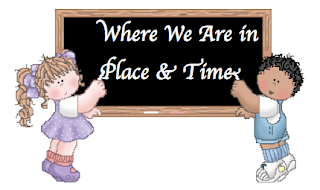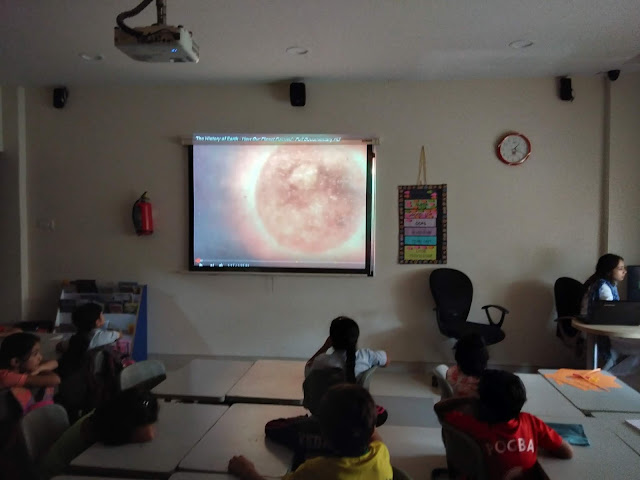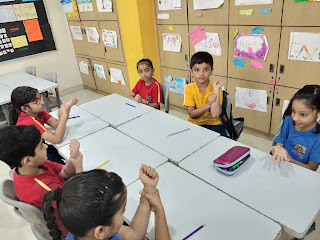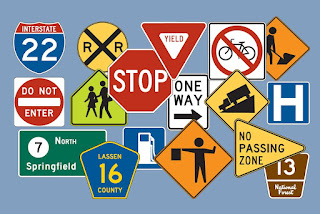A class of seven year old inviting the world into their classroom
Theme- Where we are in place and time
Central Idea- Geographical features has an impact on human interactions and settlements.
Lines of Inquiry-Various changes in natural features around the world.
The relationship between location and settlement.
Impact of human interaction on physical environment.
Key concepts: Form, Causation, Connection
Related concepts: Geography, Settlement, Modification, Structure and Properties
ATL skills: Thinking and Research Skills
Attributes: Inquirer, Reflective, Thinker
Attitudes: Independence, Curiosity and Appreciation Through this theme, students enhanced the following:
Strand:Social Studies (Human and Natural environment) & Science (Earth and Space).
Young children as we all know have boundless curiosities about the world around them. Not surprisingly, one never-ending source of interest is learning about how other people’s lives differ from their own. Through this unit we focused on ‘How geography shapes settlement’. It was designed as an absorbing and age-appropriate introduction to the learning of Social Studies. Students inquired and learnt about local and globally significant issues in context to this unit. Students tuned into the unit as they inquired into the orientation in place and time to understand the progress of time and things around them making clear connections to the Theme- Where We Are in Place and Time.
They attended to the concept of change as they watched a video clipping of the 7 continents being formed and then engaged themselves in identifying and labeling the continents on maps of the world of then and now, presenting their understanding of the theme - Where we are in place and time.
Students also addressed the related concept of time as they viewed two videos on Mumbai city to increase their knowledge and understanding about the different features of the city, which have changed over time. Students then made use of a graphic organizer ‘Then and Now’ to compare how the city was in the olden times and how it has changed now. Through all these learning engagements, students demonstrated their prior knowledge and were further provoked to inquire further into their unit.
To further engage them in the orientation of time and place, students made connections with the theme and shared their knowledge, by drawing a picture of themselves in relation to place. Based on their prior knowledge engagement, students introspected on various questions. They further used their thinking skills and illustrated where they belong through a graphic organizer -“Concentric Circle”. (School, Class, Worli, Mumbai, Maharashtra, India, Asia etc).
Students were given an opportunity to build meaning and refine their understanding through structured inquiry as they demonstrated their prior knowledge about world Geography (addressing the related concept) as they were provided with a blank world map to which they labeled all the land forms known to them. Students thus understood that everything has a form with recognizable features that can be observed, identified and categorized. After students understood the concept of Form they demonstrated an understanding about the physical geography of the world around them. They also viewed visual cues to inquire into how the Earth was formed and how the different land forms came into existence, thus aiding them to understand more about the physical world.
Planet Earth Students understood and appreciated the uniqueness of our planet earth and earth surface which is the part of our planet that we interact with everyday. Later students drew a map that showed what the playground would look like from above. Students also observed and included natural features of the land, such as hills, puddles, grassy areas and trees. Also they were be asked to add human made features to their maps such as cement sidewalks, gardens, sports fields. Further they watched the video on formation of Earth.
Students were facilitated to understand the term settlement through three videos based on human settlements and geography. They further reflected on the same and demonstrated their understanding of a settlement by illustrating where they would like to settle.
Students further expanded their understanding that the place they are settled in has an important influence on people’s culture (human interaction). Students realized that it is the distinctive feature of a place that gives it, its identity. They were curious about the nature of learning, about the world, understanding that the world they live in consists of interacting systems in which actions of any individual affects others, thereby addressing the concept of Connection and related concept of Settlement.
To familiarizing students with the Term “Interaction”
Teacher fabricated a scenario in which students would need to work together and solve problems to succeed, like being stranded on a deserted island or getting lost at sea. They were asked to work together to concoct a solution that ensures everyone arrives safely. Students came up with a list of 10 must-have items that would help them most, or a creative passage to safety. Students were further encourage to vote — everyone must agree to the final solution.
Students cooperated with each other whilst collaborating within the groups .They also learned to be appreciative and respectful of the world and its people. They exercised initiative in applying their thinking skills critically on the various questions and made reasoned decision. They further implemented their thinking skills and wrote the different ways of interacting through a mind-map.
Subsequent to the understanding of the term interact; it was essential to unpack the term impact. Actively using the various forms of communication skills like listening, speaking and writing, the students participated in 2 simple experiments.In the first experiment the students were asked to hold their wrist tight for a few seconds. For the second experiment students were made to write a sentence with their pencils in a book. They were asked if they saw anything unusual. Following which they were asked to press the pencil really hard whilst writing. The reaction being, the impression of the letters appears on the following pages too. In both the cases the students brainstormed on what happened to their wrist and what took place due to the force applied. The teacher inspired the students about the reasons for the same. They were made to realize that there was an action which has caused the reaction. Students were motivated to come up with various expressions, ultimately leading to the word impact.
To further comprehend and connect the terms interaction and impact, students used the “Rocket write” strategy and composed a list of 5 different ways in which they interacted on that day. They further introspected on whether their interaction through the day had been negative or positive and made a note of the same.The teacher then formulated with the students the term “environment.” Students come up with their own explanations of the term environment and they illustrated different ways in which they interact with the environment through a “Spider Diagram.”On the whole students listened to directions and information and gained an enduring understanding of the terms interact and impact. They spoke clearly, expressing their ideas and stating their opinions. In addition the students exercised initiative in applying thinking skills critically and creatively and realized how things are connected to one another, recognizing their relationships with the systems of the community they interact with.
After an in-depth inquiry into the terms ‘interact’ and ‘impact and the students were ready to now inquire into the negative impact of our interaction with the environment. Students were provoked through several videos indicating destruction of our environment. (Pollution, car emitting smoke, someone scribbling on the wall, littering, plucking leaves, cutting down trees etc). Students then reflected on their previous understanding of how they interact with and illustrated how their interaction has an impact on the environment. Moving on they enhanced their knowledge about positive and negative impact of human interaction. Negative impact on the environment not only causes disaster on a large scale but affects the smallest of creatures on our planet- Earth.
Thus the students demonstrated the attitude of curiosity about learning in relation to the world and its people. They gained an enduring understanding about the impact of human actions on the environment. They understood the concept of causation, that things do not just happen and that our actions have consequences. They made connections with the environment, to understand that in order to save the same we humans have to make sensible choices when interacting with it. They as a result made connections with their responsibility towards the environment and developed the attitude of empathy where they realized that everyone can take an initiative towards improving the environment irrespective of how big or small the action is. Students were further facilitated about the positive and negative human interaction with the environment. Later the students reflected, illustrated and wrote about their new learning. To further enhance their knowledge during circle time the students got a variety of books and sat together cooperatively and shared their new knowledge. They developed their social skills.
After realizing the adverse effects of human interaction and its impact on the environment and the consequences of the same, students understood that it is each individual’s responsibility to protect and safeguard all living things that share the planet and hence decided to take ACTION. Students in various ways present how our interactions can have an impact on the environment, ways of saving it and the little steps we can take to make a difference.
Following which to sum up the unit and as a part of their SUMMATIVE ASSESSMENT, students watched various videos to understand the impact of human interaction on the physical environment.
The students explored any one land form selected by them. They researched on the same by using I-pads. Teachers generated QR codes which helped to direct students to the correct URL site. Thus they were able to check all the site which provided them with appropriate and age level information. After researching about various land forms students created a 3-D model of the same using the materials provided to them. Further students was provided as a situation where a natural calamity had struck at the location where they were settled in. Students reflected back on their previously gained knowledge and came up with a solution relating to the various effects of a natural calamity. Students’ imagined themselves in the given situation to understand their reasoning and emotions on the impact of human interactions on the environment. They gave thoughtful consideration to their previously acquired learning and experience, learning to respect the world around them.
All in all this entire unit truly enabled the students to be aware of their place in the world; and to understand human influences on the world. It has stimulated their interest in their surroundings and in a variety of human and physical conditions on the Earth's surface. Thus, this Unit has not only helped in fostering their intellect in valuing beauty of the world around them but has also helped students in developing an informed concern about the quality of the environment and the future of the human habitat. The end result being that the students emerged as knowledgeable and responsible individuals and we are truly proud of them.
Math = Love
We created Math = love because we wanted both teachers and students to know that learning math skills can be fun.
Shapes Everywhere
Students used various tangram geometric manipulative to explore shapes and further they made identified those shapes and also created patterns and design using the manipulative.
All in all this entire unit truly enabled the students to be aware of their place in the world; and to understand human influences on the world. It has stimulated their interest in their surroundings and in a variety of human and physical conditions on the Earth's surface. Thus, this Unit has not only helped in fostering their intellect in valuing beauty of the world around them but has also helped students in developing an informed concern about the quality of the environment and the future of the human habitat. The end result being that the students emerged as knowledgeable and responsible individuals and we are truly proud of them.
Math = Love
We created Math = love because we wanted both teachers and students to know that learning math skills can be fun.
Shapes Everywhere
Students used various tangram geometric manipulative to explore shapes and further they made identified those shapes and also created patterns and design using the manipulative.
Symmetry
Students created a symmetrical painting using water colors and identified the line of symmetry by folding the paper into two halves.
Symmetry Painting
Math Challenge
To make math relevant and realistic, facilitators provided students with a math challenge based on the read aloud book (My Father's Dragon) which was read to the students during read aloud sessions.Wherein students to made Elmer's old alley cat using various shapes provided, make a sweater for the old alley cat using counting cubes and late counted the total number of cubes to understand the concept of place value.
Making a Bridge
Making a Bridge
Our read aloud character needed help to make a bridge. Students helped Elmer Elevator to build the bridge by using connecting cubes. They later counted and added the cubes to understand the concept of addition and place value.
Punctuation Power
Punctuation Power
After reading books in DEAR session students were curious to know the usage of various punctuation like exclamation, comma, question mark. Hence students lead an inquiry into the same. They read the book i.e. Exclamation Mark by Amy Krouse Rosenthal and Tom Lichtenheld which helped them to understand the concept of exclamation, question mark and a period. Further facilitators made a whole class chart which provided the students with an opportunity to write their own definition and come up with examples.
Budding Writers
To make writing more fun and creative facilitators provided a prompt which was in relation to the read aloud book, wherein students imagined themselves as one of the character from My Father's Dragon book and weaved a story based on the character's problem and provided a solution to the same.
Creative Writing
Creative Writing
In Creative writing students discussed the main components of a story (e.g., characters, setting, plot and theme OR beginning, middle, end) Further they were provided with a blank story map organizer and completed a paragraph using the story map. Later they published their written piece in the class. This activity was a great fun and a new learning experience for grade 2 kids.

































Comments
Post a Comment